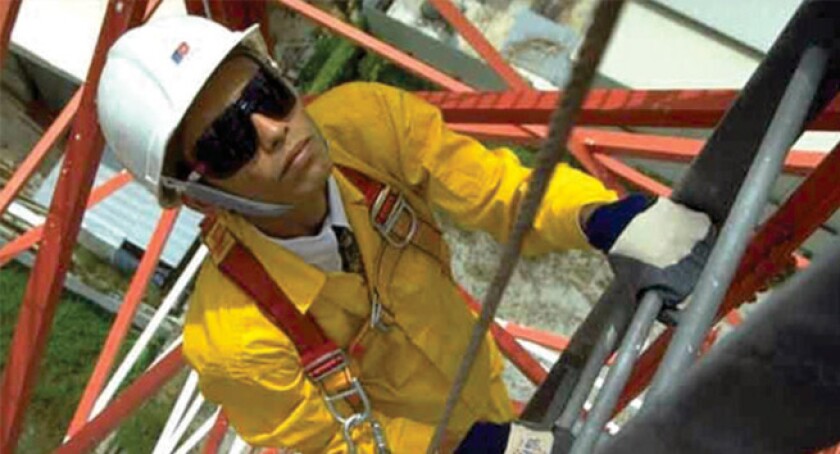Worldwide fall protection leaders Capital Safety introduce us to the key elements of a fall protection plan, and the personal protective equipment necessary to ensure tower climbers return home safely from every job.
TowerXchange: Please introduce yourself and Capital Safety - what role do you play in the telecoms infrastructure ecosystem?
Denis Perotti, Export Director for Africa, Capital Safety:
Capital Safety Group (CSG) as a worldwide fall protection leader has been very active in the Telecom market in Africa for more than a decade. Providing expertise, site surveys, product recommendations, training for working at height and incessantly improving the Health & Safety practices are the daily work of our team.
TowerXchange: How would you describe the current culture and attitudes toward health and safety in Africa?
Denis Perotti, Export Director for Africa, Capital Safety:
Health & Safety in Africa is improving, but a lot has to be done in the future. The culture of Health & Safety is driven by international companies (such as telecom operators) who are pushing all contractors and partners to improve their safety consciousness. Most of the time local regulations and standards are quite poor but Capital Safety is a key actor in education and mindset change of local players.
TowerXchange: How do you train individuals / how do you change cultural attitudes toward tower climbing and fall protection?
Denis Perotti, Export Director for Africa, Capital Safety:
In the field, CSG is able to improve the practices of Working at Height through:
Fall protection awareness leaflets
Working at height Seminars
On site demonstration
Risk analysis assessment
Wide offer of training programs for both professional trainers and people working at height
TowerXchange: What are the key components of a fall protection plan in telecommunications?
Denis Perotti, Export Director for Africa, Capital Safety:
The fall protection plan consists of evaluating the risk and to proposing the adequate equipment (Personal Protective Equipment commonly called PPE).
TowerXchange: What does comprehensive Personal Protective Equipment include, and what does it cost?
Denis Perotti, Export Director for Africa, Capital Safety:
An anchorage point, a full body harness, connectors and a deceleration device are the key components of a fall protection system in order to bring every worker safe at home every day.
Most of the tower climbers are using a full body harness and a twin shock absorbing lanyard but a temporary or permanently installed Vertical Lifeline offers the best protection against a fall.
The cost of such a solution depends on the quality of the materials and the lengths of the system.
TowerXchange: What safety considerations should ideally be factored into the design of telecom towers? How can these features be “retrofitted” at legacy towers?
Denis Perotti, Export Director for Africa, Capital Safety:
Until today we see new towers equipped with a cage ladder configuration. We have to say that the cage ladder was created in the 1950’s and does not offer any safety in case of fall. Moreover the cage ladder does not allow the set up of a rescue plan after a fall.
In addition a cage ladder costs twice as much as a permanently installed vertical life line and reduces the weight of the tower, offering a 100% safe solution for the worker.
Any towers can be equipped with a fall protection system.
TowerXchange: What are the global standards applicable to fall protection, and could you summarise the obligations they set out for employers?
Denis Perotti, Export Director for Africa, Capital Safety:
First of all each country or group of countries follows its own standards (Osha-Ansi in USA, CSA in Canada…). When we speak about Africa we commonly refer to European Standards.
If we refer to the European standard and particularly to the European Directive 89/656/EEC we can say in brief that :
The employer has to provide adequate PPE to the worker free of charge
The worker has to participate in the PPE selection
The employer must provide to the worker information about the risk and the conditions of use of the PPE
The employer must provide adequate instructions concerning the use of the PPE, including training.
TowerXchange: Finally, please sum up how you would differentiate Capital Safety’s products and services from competitive fall protection manufacturers?
Denis Perotti, Export Director for Africa, Capital Safety:
Innovation, reliability, expertise, experience (more than 50 years of existence) and dedication to fall protection makes CSG unique in the fall protection world.
In addition, all Capital Safety employees are committed with two words: passion and trust.
Passion because our engineers are able to create new solutions, to work with end users, to understand their requirements and to deliver the best in class product. And all CSG employees are dedicated to provide the best assistance on a daily basis in order to save lives.
Trust because today CSG is the only international company specialised in fall protection all over the world. With more than 20,000 references complying with all the international standards (OSHA – ANSI, CE - EN, …).
By the way CSG is offering a lot of unrivaled and unique solutions all over the world.
Finally, CSG is offering through its extensive network of training centers access to education, training and knowledge.

